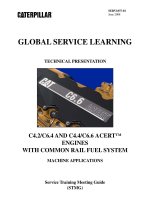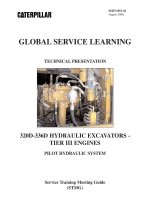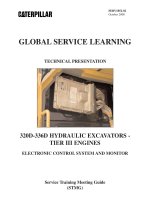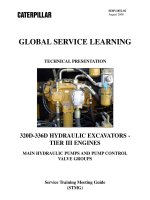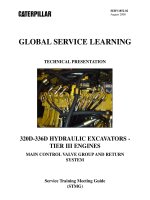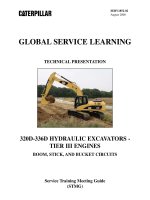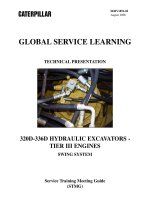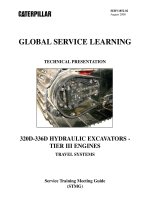Hệ thống thủy lực máy đào CATERPILLAR SERIE D - P10
Bạn đang xem bản rút gọn của tài liệu. Xem và tải ngay bản đầy đủ của tài liệu tại đây (1.34 MB, 52 trang )
SERV1852-02
October 2008
320D-336D HYDRAULIC EXCAVATORS -
TIER III ENGINES
DEMAND FAN SYSTEMS
Service Training Meeting Guide
(STMG)
GLOBAL SERVICE LEARNING
TECHNICAL PRESENTATION
320D-336D HYDRAULIC EXCAVATORS -
TIER III ENGINES
DEMAND FAN SYSTEMS
AUDIENCE
Level II - Service personnel who understand the principles of machine systems operation,
diagnostic equipment, and procedures for testing and adjusting.
CONTENT
This presentation provides an introduction and describes the components and systems operation
of the 320D-336D hydraulic excavator demand fan systems. Additional presentations will
cover the machine walkaround, engines, pilot system, main control valve group, implements,
swing system, travel system, and tool control systems in more detail. This presentation may be
used for self-paced and self-directed training.
OBJECTIVES
After learning the information in this presentation, the technician will be able to:
1. identify the correct operation of the demand fan systems used on the 300D Series
hydraulic excavators for engine cooling, and
2. diagnose problems in the fan systems.
REFERENCES
320D Hydraulic Excavator Specalog AEHQ5856
323D L and 323D LN Hydraulic Excavators HEHH3327
324D Hydraulic Excavator Specalog AEHQ5663
325D Hydraulic Excavator Specalog AEHQ5665
328D Hydraulic Excavator Specalog AEHQ5706
330D Hydraulic Excavator Specalog AEHQ5667
Machine Monitoring System - Systems Operation RENR8068
Self-study "300D Series Hydraulic Excavators, 345C Hydraulic Excavator,
and 365C & 385C Large Hydraulic Excavators SERV7032
iTIM " '300C' Series Hydraulic Excavators-Electronic Control Systems" SERV2693
iTIM "325C Hydraulic Excavators-Hydraulic Systems" SERV2701
325D Hydraulic Schematic KENR6157
Estimated Time: 1 Hour
Illustrations: 41
Form: SERV1852-02
Date: September 2008
© 2008 Caterpillar
TABLE OF CONTENTS
INTRODUCTION ........................................................................................................................5
HYDRAULIC DEMAND FAN SYSTEM...................................................................................6
Cat ET Screens for the Hydraulic Cooling Demand Fan.....................................................19
Monitor Screens for the Hydraulic Cooling Demand Fan ...................................................20
VISCONIC DEMAND FAN SYSTEM (ATTACHMENT).......................................................33
Cat ET Screens for the Visconic Cooling Demand Fan.......................................................46
Monitor Screens for the Visconic Cooling Demand Fan .....................................................51
CONCLUSION...........................................................................................................................52
SERV1852-02 - 3 - Text Reference
10/01 Demand Fan Systems
SERV1852-02 - 4 - Text Reference
10/01 Demand Fan Systems
PREREQUISITES
"Fundamentals of Mobile Hydraulics Self Study Course" TEMV3002
"Fundamentals of Power Train Self Study Course" TEMV3003
"Fundamentals of Electrical Systems Self Study Course" TEMV3004
"Fundamentals of Engines Self Study Course" TEMV3001
NOTES
Nomenclature Change: During the fourth quarter of 2008, the 325D and 330D
nomenclature changed. The 325D became the 329D and the 330D became the 336D for
most arrangements.
The exceptions are as follows:
- The nomenclature for the 325D MH and 330D MH did not change.
- The nomenclature for the 325D FM and 330D FM did not change.
- The 325D HD HW did not change into 329D HD HW. This model is being discontinued.
However, the 330D HD HW changed to the 336D HD HW.
SERV1852-02 - 5 - Text Reference
10/01 Demand Fan Systems
INTRODUCTION
There are two types of demand systems used on the 320D-336D Hydraulic Excavator to control
the cooling fan for the engine:
- Hydraulic demand fan system (330D/336D Only): The hydraulic demand fan system is
made up of a fan motor and fan pump to cool the hydraulic oil, engine radiator, fuel
cooler, and the ATAAC. A reversing fan attachment is available for the hydraulic demand
fan system.
- Visconic demand fan system (320D, 321D, 323D, 324D, 325D, 328D and 329D): The
visconic demand fan system uses a viscous coupling between the engine mounted, belt
driven fan drive hub and the fan assembly.
NOTE: The cooling fan viscous coupling is sometimes called the fan clutch. A fan
clutch is a thermostatically-controlled device. When the engine is cool or even at
normal operating temperature, the fan clutch partially disengages the engine's
mechanically-driven cooling fan. This decoupling saves power since the engine does
not have to fully drive the fan.
If engine temperature rises above the fan clutch's engagement temperature setting, the
fan becomes fully engaged, When the fan clutch is fully engaged, the fan draws a
higher volume of ambient air through the radiator, which in turn serves to maintain or
lower the engine coolant temperature to an acceptable level.
1
320D - 336D
EXCAVATORS - TIER III ENGINES
DEMAND FAN SYSTEMS
© 2008 Caterpillar
SERV1852-02 - 6 - Text Reference
10/01 Demand Fan Systems
2
HYDRAULIC DEMAND FAN SYSTEM
The hydraulic demand fan system is made up of a fan motor and fan pump to cool the hydraulic
oil, engine radiator, fuel cooler, and the ATAAC.
The electronically controlled, variable displacement, piston fan pump is driven off of the main
hydraulic system drive pump. The fan pump flow output is controlled by the angle of the
swashplate.
A solenoid on the fan pump receives a PWM signal from the Machine ECM to control the
pump swashplate.
When the machine is running, the hydraulic oil temperature sender and the engine coolant
temperature sensor sends signals to the Engine ECM. The Engine ECM then sends this
information to the Machine ECM. The Machine ECM picks up the hydraulic temperature
through the monitor.
Hottest
Coldest
Increasing
Coolant
Temperature
>
92 C
<
81 C
87
C
Water
Pump
Engine
Oil Cooler
330D/336D HYDRAULIC DEMAND FAN
COOLING SYSTEM
ENGINE AT OPERATING TEMPERATURE
Cab
Heater
Thermostat
Housing
To Cylinder
Block
Coolant
Expansion
Tank
Coolant
Bypass Tube
Coolant Temp
Sensor
Fill Cap
Engine ECM
CDL
Fan Drive
Pump
ATAAC
Hydraulic Oil
Cooler
Radiator
Top
Tank
Slow Return
Check Valve
Fan
Motor
Main
Return
Filter
Hydraulic
Circuits
Case Drain
Filter
Hydraulic Oil
Temp Sender
Monitor
CAN Data Link
Intake Manifold
Air Temperature Sensor
OK
Machine ECM
SERV1852-02 - 7 - Text Reference
10/01 Demand Fan Systems
The Machine ECMs interpret the information from these inputs to send a PWM signal to the
fan pump solenoid to control the angle of the pump swashplate to control the pump flow.
A higher temperature input will cause the Machine ECM to send a reduced PWM signal to the
fan pump solenoid. The reduced signal causes the pump to upstroke to increase pump flow,
which increases the speed of the fan for more cooling capacity.
SERV1852-02 - 8 - Text Reference
10/01 Demand Fan Systems
3
The variable displacement fan pump is driven off of the drive pump, which is part of the main
pump group (2).
The pump control valve group (3) features a pressure control solenoid (4), which is controlled
by the Engine ECM.
The pump control valve group has two adjustment screws:
- The upper screw, next to the pump control solenoid, is below the cap (5). This screw is
used to adjust the pump control spool.
- The lower screw (6), below the pump control valve group, is used to adjust the pressure
control spool.
The reservoir supply line (7) is below the fan pump housing, while the pump supply line (8) to
the motor is above the housing.
NOTE: In most cases, the two adjustment screws should not be used. The solenoid can
be calibrated through Cat ET or the monitor to correctly set the fan pump control.
1
2
3
4
5
6
7
8
SERV1852-02 - 9 - Text Reference
10/01 Demand Fan Systems
The 330D/336D engine fan (1) is hydraulically driven by a fixed displacement motor (2).
The variable displacement fan pump supplies oil to rotate the fan motor. Fan speed is varied to
provide optimized cooling. The optimum fan speed is calculated using engine coolant
temperature and hydraulic oil temperature.
Case drain oil from the fan motor is combined with the case drain oil from the swing and travel
motors. Return oil from the fan motor is sent to the return filters and into the hydraulic tank.
An internal makeup valve in the fan motor is used to prevent cavitation when flow from the fan
pump stops.
The direction of the engine fan can be reversed on machines equipped with the reversible fan
option. The fan motor rotation can be changed with the monitor. The reversal of the fan motor
is used to clear debris and dust from the radiator and hydraulic oil cooler.
4
1
2
SERV1852-02 - 10 - Text Reference
10/01 Demand Fan Systems
The radiator access compartment is located in front of the counterweight. The door is hinged
on the right and has a locking latch on the left side to keep it closed. This door provides access
for cleaning some of the cooling system components as servicing some of the fuel system and
cooling system components.
- hydraulic oil cooler (1)
- Air to Air After Cooler (ATAAC) (2)
- radiator (3)
- engine coolant overflow bottle (4)
5
1
2
3
4
SERV1852-02 - 11 - Text Reference
10/01 Demand Fan Systems
6
This illustration is a schematic of the fan system with the fan at maximum controlled pressure,
resulting in maximum controlled fan speed.
The hydraulic demand fan is standard on the 330D/336D Hydraulic Excavators. The fan is part
of the hydraulic system, but it is controlled by the Machine ECM.
The intake manifold air temperature sensor and the coolant temperature sensor are inputs into
the Engine ECM. The Engine ECM provides information to the Machine ECM from these two
sensors. The Machine ECM also receives information from hydraulic temperature sensor
through the monitor.
The Machine ECM evaluates these three sensor inputs for controlling the fan. A target speed
for the cooling fan is assigned for each engine speed based on the output of the various
temperature sensors. The target values for the maximum fan speeds are assigned by specific
software designed for the 330D/336D machine models.
The Machine ECM sends a PWM signal to the fan pump proportional solenoid to control the
flow from the pump. The pump flow is directed to the fan motor, to rotate the motor, which
causes the fan to turn to provide engine cooling.
Fan Motor with
Makeup Valve
Pressure
Control
Solenoid
Fan Pump Group
Pump
Control
Valve
Small Actuator
Piston
Large Actuator
Piston
Machine ECM
Coolant Temp
Sensor
Intake Manifold
Air Temperature Sensor
CDL
Monitor
CAN Data Link
Engine
ECM
Hydraulic Oil
Temp Sender
Main Return
Filter
OK
Minimum
PWM Signal
330D / 336D STANDARD HYDRAULIC FAN DRIVE SYSTEM
MAXIMUM CONTROLLED FAN SPEED
SERV1852-02 - 12 - Text Reference
10/01 Demand Fan Systems
When engine coolant and/or hydraulic oil temperatures are high, the fan speed is increased. If
the temperatures are low, the fan speed is decreased. The higher the ambient temperature, the
higher the fan speed, as well.
For high temperature readings the Machine ECM sends the minimum software controlled PWM
signal to the fan pump pressure control solenoid to upstroke the hydraulic pump to increase the
pump flow.
When maximum pump flow is sent to the fan motor, the fan rotates at the maximum software
controlled rpm.
Cat ET or the monitor can be used to check or calibrate the fan speed. Refer to the 330D/336D
Test and Adjust Manual for the calibration procedures.
Maximum mechanical pump pressure and maximum fan speed (high pressure cut-off) can be
achieved by disconnecting the electrical connection to the solenoid or by using Cat ET to turn
OFF the fan control (Engine ECM/Configuration screen).
If communication is lost between the Engine ECM and the fan pump pressure control solenoid,
the fan will default to the maximum mechanical pressure setting (high pressure cutoff). This
action results in a higher system pressure. This pressure is higher than the maximum pressure
controlled through the software. The fan speed is also higher than the maximum fan speed
normally controlled by the software.
The makeup valve in the fan motor is used to prevent cavitation when flow from the fan pump
stops.
SERV1852-02 - 13 - Text Reference
10/01 Demand Fan Systems
7
The Machine ECM sends the minimum PWM signal (software controlled) to the fan pump
pressure control solenoid when conditions require maximum controlled fan speed.
The pressure control spool spring forces the top half of the pressure control spool up, against
the solenoid pin and holds the lower land of the upper pressure control spool against the seat
when the solenoid receives the minimum PWM signal.
This movement blocks most of the pump output oil in the pump control spool spring chamber
from draining to tank through the case drain passage, which causes the pump control spool
spring chamber to become pressurized.
The force of the spring at the top of the pump control spool, plus the pressure of the oil, is now
greater than the oil pressure at the bottom of the pump control spool. The pump control spool
moves down, blocking pump output oil from entering the signal passage to the large actuator
piston in the pump. The large actuator piston is open to drain around the pump control spool.
Pump Output
to Fan Motor
Large
Actuator
Small Actuator
and Bias Spring
Swashplate
Drive
Shaft
Piston and
Barrel Assembly
Pump
Control
Spool
Pressure
Control
Spool
Spring
Pin
Signal Passage
to Actuator Piston
Springs
Case
Drain
Passage
Adjustment
Screw
Orifice
330D /336D FAN PUMP AND CONTROL VALVE
MAXIMUM CONTROLLED FAN SPEED
Pressure
Control
Solenoid
Minimum PWM
Signal
Adjustment
Screw
SERV1852-02 - 14 - Text Reference
10/01 Demand Fan Systems
The bias spring and the small actuator move the pump swashplate to an increased angle, which
causes the pump to UPSTROKE. This condition provides a controlled maximum flow of oil to
the fan motor and creates the maximum controlled fan pump system pressure, which results in
the maximum controlled fan speed. If the solenoid fails (no current to the solenoid), the pump
goes to maximum displacement.
With no current to the pressure control solenoid, the pump control spool (high pressure cut-off)
will limit the maximum pressure and the fan speed to its maximum rpm. This state can be
achieved by disconnecting the fan pump control solenoid or by using Cat ET to turn the fan
control OFF. This procedure is required when making adjustments to the fan system pressure
settings.
The mechanical high pressure cutoff is adjusted using the adjustment screw. When the
adjustment screw is turned in (clockwise), it increases the force of the pressure control spool
spring, which increases the the pump pressure required to unseat the land of the upper pump
control spool, thereby increasing maximum cutoff pressure.
Maximum cutoff pressure will be lowered when the screw is turned out (counter-clockwise).
NOTE: The 330D/336D service manual currently does not provide test procedures for
checking the maximum and minimum fan speeds outside the control of the software.
The D8T and D9T Track-type Tractor uses a similar cooling fan system. The D8T and
D9T test procedures for checking the maximum and minimum fan speeds can be used as
reference, however, the specifications will be different. A tee for a pressure tap will also
have to be installed in the line to the fan motor.
The pump control spool is also shown as being adjustable. Increasing the spring setting
would create higher system pressures and higher fan speeds for a given PWM signal to
the pressure control solenoid and vice versa for decreasing the spring setting. If the
spool is adjusted a pressure control solenoid calibration should be done to compensate
for the change to the pump control spring.
SERV1852-02 - 15 - Text Reference
10/01 Demand Fan Systems
8
This illustration is a schematic of the hydraulic fan system with the fan at minimum speed.
When the Machine ECM sends the maximum software controlled PWM signal to the fan pump
pressure control solenoid, the pump destrokes to the minimum swashplate angle. At the
minimum swashplate angle the pump produces the minimum controlled flow resulting in the
fan turning at the minimum fan speed.
When the fan pump pressure control solenoid is at the maximum software controlled PWM
signal, the pressure control spool is unseated by the solenoid, allowing some of pump supply
oil to drain to the tank. This action reduces the pressure in the spring chamber of the pump
control spool and the pump control spool shifts up due to the higher pump supply pressure.
When the pump control spool moves up, pump flow is directed to the large actuator. As
pressure builds in the large actuator, the large actuator overcomes the bias spring and the small
actuator piston to the destroke pump. With the pump destroked, oil flow to the fan motor is
reduced which reduces the fan speed.
Fan Motor with
Makeup Valve
Pressure
Control
Solenoid
Fan Pump Group
Pump
Control
Valve
Small Actuator
Piston
Large Actuator
Piston
Main Return
Filter
Coolant Temp
Sensor
Intake Manifold
Air Temperature Sensor
CDL
Machine ECM
Monitor
CAN Data Link
Engine
ECM
Hydraulic Oil
Temp Sender
OK
Maximum
PWM Signal
330D / 336D STANDARD HYDRAULIC FAN DRIVE SYSTEM
MINIMUM CONTROLLED FAN SPEED
SERV1852-02 - 16 - Text Reference
10/01 Demand Fan Systems
9
This illustration shows the fan control valve with the fan pump at minimum displacement.
If the input temperatures are below a certain value, the Machine ECM sends an increased PWM
signal to the pressure control solenoid to reduce the pump flow. The solenoid plunger and pin
push the pressure control spool down.
With the pressure control spool pushed down, the spring chamber above the pump control spool
is open to case drain around the seat on the lower end of the upper pressure control spool.
There is a pressure drop across the orifice above the pump control spool. The system pressure
is now greater than the pump control spool spring and the pressure above the pump control
spool. The supply pressure pushes the pump control spool up to block oil in the signal passage
to the actuator piston from going to drain.
The pump control spool now allows pump supply oil to flow to the large actuator piston. The
flow causes an increase in pressure in the large actuator piston. The large actuator overcomes
the combined forces of the bias spring and small actuator to move the swashplate toward
minimum angle. Pump flow decreases and therefore fan speed decreases.
330D / 336D FAN PUMP AND CONTROL VALVE
MINIMUM FAN SPEED
Pump Output
to Fan Motor
Large
Actuator
Small Actuator
and Bias Spring
Swashplate
Drive
Shaft
Piston and
Barrel Assembly
Signal Passage
to Actuator Piston
Case Drain
Passage
Pump
Control
Spool
Springs
Adjustment
Screw
Pressure
Control
Solenoid
Pressure
Control
Spool
Spring
Pin
Orifice
Maximum PWM
Signal
Adjustment
Screw
SERV1852-02 - 17 - Text Reference
10/01 Demand Fan Systems
With cold oil or at cold start-ups, the Machine ECM PWM signal to the pressure control
solenoid is at the maximum. The pump control spool moves up and supply pressure is sent to
the large actuator piston to move the swashplatetoward minimum angle. The large actuator
stops moving when the vent hole through the large actuator piston is open to case drain. The
pump flow is decreased to minimum to reduce the fan speed to minimum.
10
On machines equipped with the reversing fan attachment, the Machine ECM also controls the
reversing fan solenoid valve.
A bi-directional fan motor will replace the standard fan motor with the reversing fan feature.
Operation of the fan pump and motor makeup valve is as previously discussed.
The Machine ECM will automatically activate the fan reversing solenoid valve at
predetermined intervals, if the machine is equipped with the optional reversing fan. Fan
reversing duration may be re-configured using Cat ET or through the monitor.
When the reversing solenoid valve is energized, pilot oil is directed to the reversing spool. The
reversing spool shifts causing the flow of oil to the fan motor to be reversed. The fan motor
rotates in the opposite direction.
The relief valve opens momentarily whenever there are any pressure spikes in the system. The
relief valve also opens when the fan is first commanded to change directions (either reverse or
forward). The momentum of the fan prevents the fan motor from immediate directional change
when the flow of oil is reversed. The relief valve helps dissipate excess pressure that may
damage the system during a directional change.
Fan Motor
330D /336D REVERSING HYDRAULIC FAN DRIVE SYSTEM
Pressure
Control
Solenoid
Fan Pump Group
Pump
Control
Valve
Small Actuator
Piston
Large Actuator
Piston
Main Return
Filter
Coolant Temp
Sensor
Intake Manifold
Air Temperature Sensor
CDL
Machine
ECM
Monitor
CAN Data Link
Engine
ECM
Hydraulic Oil
Temp Sender
Pilot
Oil
Makeup
Valve
Relief
Valve
Reversing Spool
Reversing Solenoid
Valve
Radiator
OK
SERV1852-02 - 18 - Text Reference
10/01 Demand Fan Systems
11
Cat ET Screens for the Hydraulic Cooling Demand Fan
Using Cat ET, the status of the fan control system can be monitored.
The system status information can be helpful when troubleshooting the cooling system.
SERV1852-02 - 19 - Text Reference
10/01 Demand Fan Systems
12
After connecting Cat ET, go to the configuration screens.
Under Machine Control, open up the Machine Attachments parameters to view the four cooling
fan parameters.
The Engine Cooling Map parameter can be changed on all machines, but is not recommended.
This parameter requires special factory passwords to change the parameter.
If the machine is equipped with a reversing fan then the Engine Reversing Feature Installation
Status and the Engine Reverse Operation Time can also be changed.
The Engine Reversing Feature Installation Status is used to change from "Installed" to
"Disabled or Not Installed."
The Engine Reverse Operation Time allows for changing the length of time the fan reverses
during a reversing cycle.
SERV1852-02 - 20 - Text Reference
10/01 Demand Fan Systems
13
Through Cat ET, one of four different cooling fan maps can be selected. The cooling maps are
controlled by software.
The fan maps were created to allow the factories the capability to select the fan map best suited
for the marketing region each machine was being shipped to.
From the factory the 330D/336D models for NACD are only and should ONLY be configured
to High Ambient.
330D/336D machines for EAME are configured to High Ambient Temperature + Low Noise
and ISJ machines are configured to Standard + Low Noise.
The Standard cooling map is currently not being used by any of the factories.
Factory passwords are required to change the cooling fan map for the 330D/336D.
NOTE: The technician should never be required to change the cooling map. This
parameter is for factory use only. At the first release of the 330D the software did allow
the technician to change the cooling map without a factory password, but new software
was sent out to prevent this from happening.
SERV1852-02 - 21 - Text Reference
10/01 Demand Fan Systems
14
The configuration screen allows the technician to change from "Installed" to "Not Installed" for
reversing feature for the cooling fan.
If a reversing fan attachment is not installed on the machine, changing this parameter will have
no affect on the fan operation.
On machines equipped with a reversing fan attachment, this parameter allows the technician to
turn off the reversing feature if required.
SERV1852-02 - 22 - Text Reference
10/01 Demand Fan Systems
15
On the Override Parameter screen there are three cooling fan parameters that can be overridden.
Parameter overrides can be used to perform various system tests that may or not be found in the
Service Manual.
One suggested use for the Engine Coolant Fan Sol Current Override is to enter a value of 0% to
determine the maximum mechanical system pressure and 100% to determine the minimum
pressure. These two values are not part of one any of the fan cooling maps.
NOTE: The 330D/336D service manual currently does not provide test procedures for
checking the maximum and minimum fan speeds outside the control of the software.
The D8T Track-type Tractor uses a similar cooling fan system. The D8T test procedures
for checking the maximum and minimum fan speeds can be used as reference, however,
the specifications will be different. A tee for a pressure tap will also have to be installed
in the line to the fan motor.
SERV1852-02 - 23 - Text Reference
10/01 Demand Fan Systems
16
To begin the cooling fan solenoid calibration, open up the Calibration menu under Service and
Select and select "Engine Cooling Fan Calibrations.
The fan speed calibration consist of four stages:
- standby
- minimum fan speed calibration
- maximum fan speed calibration
- finish or "succeeded"
SERV1852-02 - 24 - Text Reference
10/01 Demand Fan Systems
17
The above screen shows the standby state.
Follow the directions on each screen as it appears. After the conditions are met, select "Next."
SERV1852-02 - 25 - Text Reference
10/01 Demand Fan Systems

